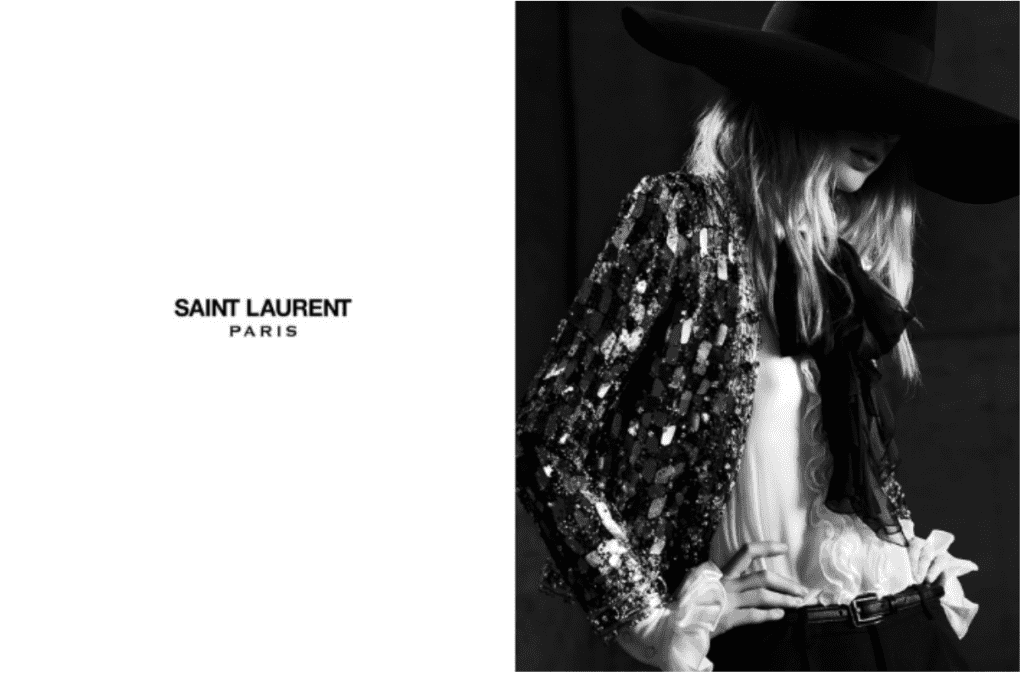On the eve of New York Fashion Week in February 2016, the eyes of the fashion world were be fixed on Los Angeles, where Saint Laurent presented one take on its Fall/Winter men’s and women’s show, followed by a second show in Paris a few weeks later. It marked a significant shift from the famed fashion brand’s usual home on the Paris Fashion Week calendar, but in actuality, it was just another in a line of bold and innovative moves by its creative director Hedi Slimane.
Mr. Slimane has transformed the French fashion house – quite literally stripping the first name of its celebrated founder “Yves” from the company’s ready-to-wear line – since taking charge in 2012. The brand’s rise has been meteoric under his direction. In the face of increasing competition from more “affordable luxury” brands, as well as other, similarly-situated bona fide luxury labels, Saint Laurent has doubled its sales revenue since Slimane took over, and helped parent company Kering to strengthen its position as a giant in the luxury industry.
Much has been written about the way Slimane the designer – how he reinvented menswear during his time at Dior Homme in the early 2000s, redefining the silhouette of the modern man and popularizing the super-skinny look – Slimane’s achievements with Saint Laurent also exemplify best practice for luxury companies.
Saint Laurent’s renewed success can first be attributed to an elegant and clever rebranding strategy which saw its name change to Saint Laurent Paris, shortly after Slimane took over. The new name represents a tribute to the original – when its eponymous founder launched his ready-to-wear line in 1966 it was under the name Saint Laurent Rive Gauche – and uses the same font and nomenclature. It also capitalizes on its city of origin, which is especially important outside of traditional European markets.
Another important aspect of the rebranding strategy is the fact that the brand puts forth the name of its creative director – items are presented in fashion magazines as “Saint Laurent by Hedi Slimane,” a move that signifies the importance of contemporary designers and suggests that their names can matter as much as the name of the traditional luxury labels that carry their collections. This has also been the case at Chanel with superstar Karl Lagerfeld’s influence as creative director. The same goes for Raf Simons at Dior, Olivier Rousteing at Balmain, etc.
The transition of the brand from a “loud” branding strategy, featuring conspicuous and highly recognizable logos, to a “quieter” one has also been an important aspect behind Saint Laurent’s success. Now it relies on more subtle tailoring details which have become associated with the brand: its signature stitching patterns, use of semi-sheer fabric and zip details.
The move to a less conspicuous – but still subtly branded – strategy shows an understanding of current luxury industry trends. Consumers are increasingly turning away from loud or heavily branded luxury products and favor more discreet goods. This can be explained by a desire not to appear too extravagant in the current financial crisis climate, as well as by a maturing of preferences – favoring products that have the cachet of appealing to connoisseurs.
Still yet, Saint Laurent has showed that luxury brands can successfully gain inspiration from the streets without losing their identity and perceived exclusivity. Saint Laurent’s inspiration from street culture is best exemplified by the recruitment of models with the right look from off the street to create shows that are edgy, while remaining elegant. Slimane has also drawn heavily upon musical inspiration. His shows commission custom-made rock soundtracks, often produced by emerging artists. And his collections have heavily referenced the grunge movement. The decision to present the AW16 collection in LA, just days before the Grammy music awards take place there, is a tribute to the city’s musical heritage. And Slimane’s combined creative and artistic direction of shows ensures their successful delivery.
As well as setting new standards for cool, the brand has placed significant emphasis on its ready-to-wear. Before Slimane, Paris-based YSL was mostly selling shoes and handbags, as so many luxury brands do. But since he joined, the brand’s ready-to-wear line has been moving off the shelves with marked frequency.
This has been impacted by the launch of a “permanent collection.” Through signature pieces, available season after season, Saint Laurent is able to exemplify the essence of luxury and luxury goods. It also ingeniously positions the brand as a reference point for timeless and classic luxury pieces.
Overall, the work done at Saint Laurent, much to the credit of its artistic director, shows how a luxury brand’s fate can be overturned. Saint Laurent’s sales are skyrocketing when other luxury brands face severe difficulties. The future of the brand however remains tied to a few questions, including its dependency on its creative director around whom rumors of a departure swirl. There is also the question of its capacity to maintain a balance between being connected to the street and pop culture, while cultivating an image of timelessness and exclusivity. Those will all be answered in time.
Benjamin Voyer is a Professor of Creativity Marketing at ESCP Europe. Edits/additions courtesy of TFL.














